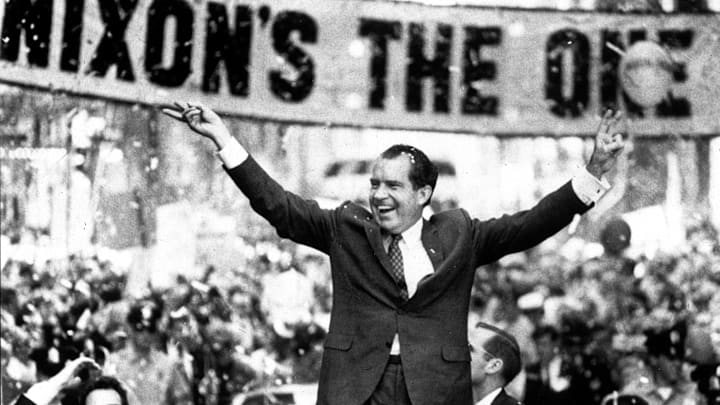U.S. PRESIDENTS (1913–1994); YORBA LINDA, CALIFORNIA
The Watergate scandal that sparked the process of President Richard Nixon’s impeachment and ultimately led to his resignation in 1974 remains one of the most infamous political events in the country’s history. But Nixon had a long career in politics before that, including an eight-year tenure as vice president under President Dwight Eisenhower. Here are some more facts you should know about the 37th president.
1. Richard Nixon wooed his wife Pat Nixon with love letters.

Richard Nixon had a little-known romantic side. After he met his future wife Thelma Catherine "Pat" Nixon—then Pat Ryan—during a Whittier Community Players theater production in 1938, he began courting her with love notes. Despite being such a stoic politician, these notes proved Nixon had a sappy side. One read: “And when the wind blows and the rains fall and the sun shines through the clouds (as it is now) he still resolves, as he did then, that nothing so fine ever happened to him or anyone else as falling in love with Thee—my dearest heart.”
2. Richard Nixon served as Vice President under Dwight Eisenhower.

Before he entered the White House as president, Richard Nixon served as vice president during the administration of President Dwight D. Eisenhower from 1953 to 1961. He almost went directly from vice president to president after earning the Republican nomination for the election of 1960, but he was bested by Democrat John F. Kennedy. It would be another eight years before Nixon ran a second time and won against Kennedy’s successor, Lyndon B. Johnson.
3. The Watergate Scandal Led to Richard Nixon's Resignation on August 9, 1974.

The resignation that ended Richard Nixon’s presidency would ultimately overshadow any accomplishments that came before it. On June 17, 1972, police arrested several burglars in the Democratic National Committee office at the Watergate complex in Washington, D.C. The criminals had been wiretapping the committee's phones and stealing documents in an effort to help Nixon's reelection bid. Over the next two years, it became clear how deeply involved the president was in the affair, despite his vehement denials. Faced with potential impeachment over what came to be known just as "Watergate," Richard Nixon resigned from the presidency on August 9, 1974. To date, he remains the only U.S. president to resign from office.
4. Richard Nixon wasn’t actually impeached.

People often think of Nixon as one of the few presidents to be impeached—but it never quite got that far. In July 1974, articles of impeachment against Nixon for his role in the Watergate scandal were approved by the House Judiciary Committee, but the president would resign before the House could actually vote to impeach him. Though there was the possibility for Nixon to be charged with crimes at a federal level, he was instead given a full pardon by President Gerald Ford on September 8, 1974, for any crimes he may have committed during the scandal.
5. Richard Nixon died of a stroke on April 22, 1994.

Shortly after suffering a stroke, former president Richard Nixon died on April 22, 1994, at age 81. His death was related to cerebral edema, a condition characterized by swelling of the brain. As is the case with most presidential funerals, Nixon’s service was attended by the surviving presidents of the time, including Bill Clinton, Gerald Ford, Jimmy Carter, Ronald Reagan, and George H. W. Bush. The Nixon family opted out of giving him the traditional five-day state funeral ceremony that’s reserved for figures of great national significance. Instead, they held the service at the Richard Nixon Library and Birthplace in Yorba Linda, California.
6. Documents at the Richard Nixon Presidential Library Received Government Protection.

Many of the documents housed at the Richard Nixon Presidential Library and Museum in Yorba Linda, California, today were nearly lost forever. Following his resignation in 1974, Richard Nixon struck a deal with the General Services Administration to surrender most materials from his administration, even those related to the Watergate Scandal. But the agreement came with a catch: Nixon reserved the right to have the documents destroyed after five years. Congress wasn’t happy about this, and it passed the Presidential Recordings and Materials Preservation Act of 1974. The law, specifically created for Nixon, stipulated that his materials needed to be turned over to the National Archives in Washington, D.C. and processed and released to the public. In 2004, an amendment was added to PRMPA that allowed these documents to be moved to the Nixon Presidential Library in California.
Famous Richard Nixon Quotes:
- “I am not a crook.”
- “No event in American history is more misunderstood than the Vietnam War. It was misreported then, and it is misremembered now. Rarely have so many people been so wrong about so much. Never have the consequences of their misunderstanding been so tragic.”
- “The Cold War isn't thawing; it is burning with a deadly heat. Communism isn't sleeping; it is, as always, plotting, scheming, working, fighting.”
- “[Always] remember, others may hate you, but those who hate you don't win unless you hate them—and then you destroy yourself.”
- “The Congress, the Administration and the public all share a profound commitment to the rescue of our natural environment, and the preservation of the Earth as a place both habitable by and hospitable to man.”
